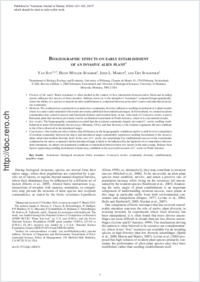Biogeographic effects on early establishment of an invasive alien plant
- Sun, Yan Department of Biology, Ecology and Evolution, University of Fribourg, Switzerland - CABI, Rue des Grillons 1, 2800 Delémont, Switzerland -
- Müller-Schärer, Heinz Department of Biology, Ecology and Evolution, University of Fribourg, Switzerland
- Maron, John L. Division of Biological Sciences, University of Montana, Missoula, Montana, USA
- Schaffner, Urs CABI, Rue des Grillons 1, 2800 Delémont, Switzerland
-
01.04.2015
Published in:
- American Journal of Botany. - 2015, vol. 102, no. 4, p. 621–625
English
Premise of the study: Biotic resistance is often studied in the context of how interactions between native biota and invading species influence the success of those invaders. Seldom, however, is the strength of “resistance” compared biogeographically, where the ability of a species to impede invader establishment is contrasted between an invader’s native and introduced recipient community.Methods: We conducted an experiment to examine how community diversity influences seedling recruitment of a plant invader where it is native and contrasted with results previously published from introduced ranges. In Switzerland, we created recipient communities that varied in species and functional richness and invaded them, or not, with seeds of Centaurea stoebe, a native European plant that has been previously used in an identical experiment in North America, where it is a prominent invader.Key results: The biogeographic comparison revealed that the recipient community largely prevented C. stoebe seedling establishment at home (Switzerland), but not away (Montana, USA), and that diversity of the resident vegetation did not contribute to the effects observed in the introduced range.Conclusions: Our results provide evidence that differences in the biogeographic conditions and/or overall level of competition of resident community between the native and introduced range considerably suppresses seedling recruitment of the invasive plant, rather than resident diversity itself. In the case of C. stoebe, the surprisingly low establishment success in the experiments conducted in the native compared with the introduced range is likely to be influenced by the higher level of competition with resident community, by abiotic environmental conditions or interactions between these two factors in the native range. Release from factors suppressing seedling recruitment at home may contribute to the successful invasion of C. stoebe in North America.
- Faculty
- Faculté des sciences et de médecine
- Department
- Département de Biologie
- Language
-
- English
- Classification
- Biological sciences
- License
-
License undefined
- Identifiers
-
- RERO DOC 257838
- DOI 10.3732/ajb.1400451
- Persistent URL
- https://folia.unifr.ch/unifr/documents/304566
Other files
Statistics
Document views: 110
File downloads:
- pdf: 179
- Supplementary material: 124

